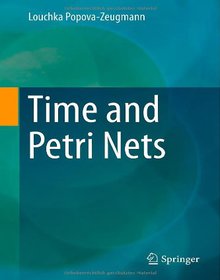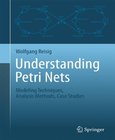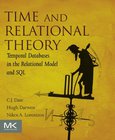Time and Petri Nets

Book Details:
| Publisher: | Springer |
| Series: | Springer |
| Author: | Louchka Popova-Zeugmann |
| Edition: | 1 |
| ISBN-10: | 3642411142 |
| ISBN-13: | 9783642411144 |
| Pages: | 209 |
| Published: | Nov 18 2013 |
| Posted: | Nov 19 2014 |
| Language: | English |
| Book format: | |
| Book size: | 3.87 MB |
Book Description:
At first glance the concepts of time and of Petri nets are quite contrary: while time determines the occurrences of events in a system, classic Petri nets consider their causal relationships and they represent events as concurrent systems. But if we take a closer look at how time and causality are intertwined we realize that there are many possible ways in which time and Petri nets interact. This book takes a closer look at three time-dependent Petri nets: Time Petri nets, Timed Petri nets, and Petri nets with time windows.The author first explains classic Petri nets and their fundamental properties. Then the pivotal contribution of the book is the introduction of different algorithms that allow us to analyze time-dependent Petri nets. For Time Petri nets, the author presents an algorithm that proves the behavioral equivalence of a net where time is designed once with real and once with natural numbers, so we can reduce the state space and consider the integer states exclusively. For Timed Petri nets, the author introduces two time-dependent state equations, providing a sufficient condition for the non-reachability of states, and she also defines a local transformation for converting these nets into Time Petri nets. Finally, she shows that Petri nets with time-windows have the ability to realize every transition sequence fired in the net omitting time restrictions.These classes of time-dependent Petri nets show that time alone does not change the power of a Petri net, in fact time may or may not be used to force firing. For Time Petri nets and Timed Petri nets we can say that they are Turing-powerful, and thus more powerful than classic Petri nets, because there is a compulsion to fire at some point in time. By contrast, Petri nets with time-windows have no compulsion to fire, their expressiveness power is less than that of Turing-machines.This book derives from advanced lectures, and the text is supported throughout withexamples and exercises. It issuitable for graduate courses in computer science, mathematics, engineering, and related disciplines, and as a reference for researchers.
Download Link:
Related Books:
Understanding Petri Nets
Modeling Techniques, Analysis Methods, Case Studies
With their intuitive graphical approach and expressive analysis techniques, Petri nets are suitable for a wide range of applications and teaching scenarios, and they have gained wide acceptance as a modeling technique in areas such as software design and control engineering. The core theoretical principles have been studied for many decades and there is now a comprehensive research literature that complements the extensive implementation experience.In this book the author presents a clear, thorough introduction to the essentials of Petri nets. He explains the core modeling techniques and analysis methods and he illustrates their usefulness with examples and case studies. Part I describes how to use Petri nets for modeling; all concepts are explained ...
Time and Relational Theory
Temporal Databases in the Relational Model and SQL
Time and Relational Theory provides an in-depth description of temporal database systems, which provide special facilities for storing, querying, and updating historical and future data. Traditionally, database management systems provide little or no special support for temporal data at all. This situation is changing because: * Cheap storage enables retention of large volumes of historical data in data warehouses* Users are now faced with temporal data problems, and need solutions * Temporal features have recently been incorporated into the SQL standard, and vendors have begun to add temporal support to their DBMS products Based on the groundbreaking text Temporal Data & the Relational Model (Morgan Kaufmann, 2002) and new research led by the au...
Handbook of Distance Learning for Real-Time
And Asynchronous Information Technology Education
In information technology, unlike many other fields, the need to support the unique perspective of technologically advanced students and deliver technology-rich content presents unique challenges. Todays IT students need the ability to interact with their instructor in near-real time, interact with their peers and project team members, and access and manipulate technology tools in the pursuit of their educational objectives. The Handbook of Distance Learning for Real-Time and Asynchronous Information Technology Education delves deep into the construct of real-time, asynchronous education through information technology, pooling experiences from seasoned researchers and educators to detail their past successes and failures, discussing their techniques,...
2007 - 2021 © eBooks-IT.org



